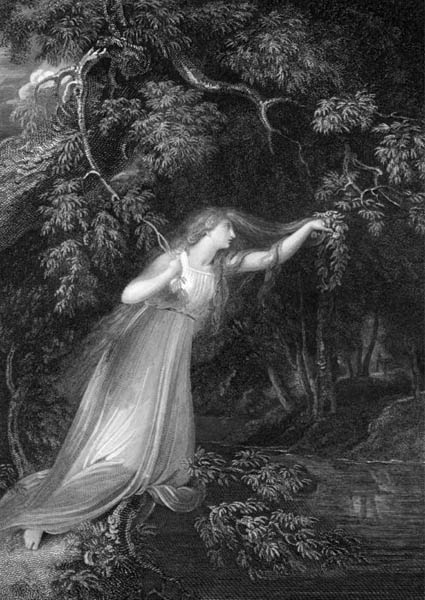
Ophelia. Painter: Richard Westall, Engraver: J.Parker, for William Shakespeare’s Hamlet, 1803. University of Tennessee, Chattanooga (WikiCommons)
This print comes from an illustrated edition of Shakespeare, one of three parts of the Shakespeare project of John Boydell (1720-1804). Boydell was a successful British engraving publisher. For his Shakespeare project, Boydell commissioned some of the best British artists of the time to paint different scenes from Shakespeare’s plays. The two other parts of the project were a folio of prints and a gallery to hang the original paintings. In part, Boydell wanted to undertake this ambitious project to improve the art of history painting in Britain. Boydell began work on the Shakespeare edition in 1786.
Ophelia is one of the main female characters in William Shakespeare’s tragic play Hamlet. Ophelia is the love interest of Prince Hamlet, and the daughter of Polonious and sister of Laertes. Ophelia is cruelly spurned by Hamlet, and then driven to madness when Hamlet accidentally kills her father.
This illustration of Ophelia was engraved by J. Parker based on an original painting for Boydell’s Shakespeare project by Richard Westall (1765-1836), a popular illustrator and portrait artist. Westall is one of the three primary illustrators that worked on the Shakespeare edition. In this image, Ophelia is shown right before she drowns. This is not shown onstage in the play, but it is described by the character Gertrude in Act IV, Scene VII, of Hamlet:
There’s a willow that leans over the brook, dangling its white leaves over the glassy water. Ophelia made wild wreaths out of those leaves…Climbing into the tree to hang the wreath of weeds on the hanging branches, she and her flowers fell into the gurgling brook.
Also in the image, Ophelia is portrayed as nearly white, a symbol of purity and innocence. Her dress alludes to her purity as well, given its simplistic, classic form that drapes around her feminine attributes without revealing them.
